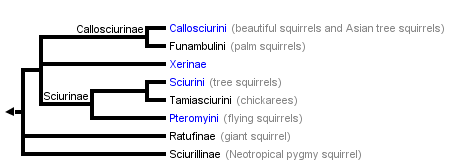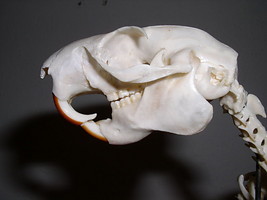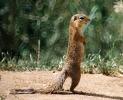Sciuridae
Squirrels
Scott J. Steppan and Shawn M. Hamm


This tree diagram shows the relationships between several groups of organisms.
The root of the current tree connects the organisms featured in this tree to their containing group and the rest of the Tree of Life. The basal branching point in the tree represents the ancestor of the other groups in the tree. This ancestor diversified over time into several descendent subgroups, which are represented as internal nodes and terminal taxa to the right.

You can click on the root to travel down the Tree of Life all the way to the root of all Life, and you can click on the names of descendent subgroups to travel up the Tree of Life all the way to individual species.
For more information on ToL tree formatting, please see Interpreting the Tree or Classification. To learn more about phylogenetic trees, please visit our Phylogenetic Biology pages.
close boxIntroduction
Family Sciuridae, the squirrels, with 278 species and 51 genera, is one of the most diverse and variable families of living mammals. Members of Sciuridae range from the common, arboreal grey squirrel in the United States, to flying squirrels, terrestrial marmots, chipmunks, semi-fossorial prairie dogs, and various terrestrial and arboreal squirrels around the world (Hoffman et al., 1993). Sciurids can tolerate a variety of environmental conditions and are found from the Arctic to the tropics, including most arid and humid regions (Wilson et al., 1996). Most sciurids are diurnal, which means they are most active during the day, and while active, they consume mostly plants, nuts and seeds, in addition to occasional insects, eggs, and small vertebrates (Wilson et al., 1996). Squirrels can be extremely social, as seen by prairie dogs with their networks of underground tunnels, or solitary, like some woodchucks. Typical squirrels, such as Sciurus carolinensis, Spermophilus lateralis, and Xerus inauris have a body mass of 0.25 kg to 0.4 kg, with lengths of about 23 to 25 centimeters (with tail of equal length). The African Pygmy squirrel, Myosciurus, however, can be as small as seven centimeters, fitting in the palm of your hand, and the Giant Red Squirrels of Southeast Asia, Ratufa, can grow to 91 centimeters in body length (including tail), reaching nearly 3 kg. The diversity and their easy accessibility during the day, has led to extensive research on behavior, ecology, reproductive biology, and morphology, which is why the Sciuridae are among the best understood mammals.
It is believed that squirrels were named back in ancient Greece, where they were called “skioros,” meaning shade tail, by the Greek philosopher Aristotle. The French began in later years to described them as “esquirel,” and in time, through other languages and interpretations, rodents with long, bushy tails became commonly known as squirrels in the English language.
With modern technological advances, such as DNA sequencing, and continuing study of morphological structures, our understanding of squirrel evolution has improved significantly (Simpson 1945; Hafner 1984; Thorington 1984; Hoffmann et al. 1993; Oshida et al. 1996; Roth 1996; McKenna and Bell 1997; Thorington et al. 1997; Thorington et al. 2002; Mercer and Roth 2003; Steppan et al. 2004; Thorington and Hoffmann in press). Within the past few years, the classification of family Sciuridae has changed considerably. Squirrels were thought to comprise two subfamilies, Sciurinae, the tree and ground squirrels, and Pteromyinae, the flying squirrels (Hoffman et al., 1993, McKenna and Bell, 1997). This division emphasized the distinctive adaptations for gliding found in the Pteromyinae. With the recent findings from molecular phylogenetics, squirrels are now classified into 5 subfamilies: Ratufinae, Sciurillinae, Sciurinae, Xerinae, and Callosciurinae, with the flying squirrels as a tribe within the Sciurinae (Thorington and Hoffmann, 2005).
Characteristics
The distinguishing features of Sciuridae are their skull structure and the position of the infraorbital canal in relation to the dental system. The sciuromorphous zygomasseteric system, where part of the lateral muscle has shifted to the rostrum, is characteristic only in those members of Sciuridae, defining them as truly sciuromorphous (Carleton and Musser, 2005). Squirrels have four large incisor teeth for gnawing, which grow the entire duration of their lives, and an additional eight cheek teeth on each of the upper and lower jaws. Each tooth row contains one pre-molar, which is very small or deciduous, and three molars, which are rooted and tubercular, for grinding down nuts and seeds. The skull is lightly built, with long post-orbital processes, the infra-orbital opening is small, and the palate is broad (Flower, 1978).
Typically, squirrels have bushy tails as long as the body, smooth coats and pointed ears. In some species, the fur coat is coarse and spiny, and in others, the ears have long hairs extending from the points. Most squirrels have cheek pouches for temporary food storage, where their cheeks will enlarge to fit more food during a single scavenge. Arboreal squirrels have double-jointed hind limbs, with four toes and a vestigial thumb that allows them to climb trees quickly. The flying squirrels have gliding membranes between the forearms and hind limbs for gliding from tree to tree.
From chirps and yelps to quick movements and tail flagging, squirrels have highly sophisticated communication, ranging from warnings to mating signals. Squirrels also have the ability to change the color of their coat during mating season. One oriental species of squirrel, Sciurus caniceps, is one of the rare known instance among mammals where their coat distinctly changes during mating season. For most of the year the squirrel’s coat is a uniform gray. From about December, its back becomes a brilliant orange-yellow, until March, when it changes back to gray (Flower, 1978).
Discussion of Phylogenetic Relationships
Our understanding of phylogenetic relationships among sciurids has improved greatly in recent years. In 1993 and until recently, family Sciuridae was classified into two subfamilies: Sciurinae, the tree and ground squirrels, and Pteromyinae, the flying squirrels (Hoffman et al., 1993; Thorington et al., 2002). After studies were conducted on cranial morphology (Roth, 1996) within these subfamilies, and the nuclear gene of the 12S rRNA was sequenced (Oshida et al., 1996), different relationships were suggested: tree squirrels (Sciurinae) were more closely related to flying squirrels (Pteromyinae) than to ground squirrels (Sciurinae). This evidence has created a problem within the traditional classification containing two subfamilies.
Phylogenetic analyses using slowly evolving nuclear DNA (Steppan et al., 2004; Mercer and Roth, 2003) have had a significant effect on the rearrangement of the phylogenetic relationships within family Sciuridae. The nuclear gene regions IRBP, RAG1, and c-myc, and the mitochondrial gene region 12S provided strong evidence that flying squirrels are derived from tree squirrels, and that they are specifically related to New World tree squirrels (Steppan et al., 2004). The five major lineages identified by Mercer and Roth (2003) and Steppan et al (2004), and followed by Hoffman et al. (2005), became subfamilies in the revised classification: Ratufinae, Sciurillinae, Sciurinae, Xerinae, and Callosciurinae. As of 2006, the accepted number of species in family Sciuridae is 278, with 51 genera, including the aforementioned five subfamilies (Thorington and Hoffman, 2005). There are only a few remaining uncertainties with respect to two aspects of the branching order among the five subfamilies, and the position of the rock squirrel Sciurotamias (Steppan et al., 2004).
Geographic Distribution
Squirrels are a geographically cosmopolitan family of rodents, found in a wide variety of habitats throughout the major land masses except Madagascar, Australia, New Zealand and Antarctica. Most species of the subfamily Callosciurinae are distributed throughout the Indomalaya ecozone, consisting of India and Southeast Asia. Ground squirrels and marmots in subfamily Xerinae are distributed among the Nearctic, Palearctic, Indomalaya and Afrotropic regions, with the highest concentration in the Nearctic region (North America).
Tree squirrels, of Sciurinae, are concentrated mostly in North and South America, with very few species located in Japan and in regions of the Middle East. Flying squirrels, also of subfamily Sciurinae, are found generally in the Indomalaya region, in addition to Russia, Japan and China. The giant squirrels in subfamily Ratufinae are limited to the Eastern hemisphere, recorded only in Indomalaya and the Palearctic, and Sciurillinae, the neotropical pygmy squirrels, exist only in the Neotropic region of South America (Wilson and Reeder 1993).
Fossil History
The first fossil records of squirrels suggest that they originated in the Northern Hemisphere, particularly North America, around 36 million years ago. The fossil of the earliest recorded squirrel, Douglassciurus jeffersoni, ranges from approximately 37.5 to 35 million years ago (Thorington and Emry 1984). This squirrel species had very similar skeletal and dental structures like those of present day squirrels, but it lacked the characteristic sciuromorphous zygomasseteric system, which classifies squirrels today (Mercer and Roth 2003). The earliest sciuromorphous squirrel fossil recorded to date is Palaeosciurus, from Europe, which is believed to have lived in the early Oligocene epoch, about 33.7 to 23.8 million years ago (Vianey-Liaud 1984). Most fossil species found thereafter range from 33.7 million years ago, to today, and the New World tree squirrel Sciurus is considered to be a “living fossil” (Thorington and Emry 1984).
References
Flower, William Henry, Sir, 1978. An Introduction to the Study of Mammals Living and Extinct, pp. 450-452. (Reprint ed.) Arno Press Inc., London.
Hafner, D. J. 1984. Evolutionary relationships of the Nearctic Sciuridae, pp. Pages 3-23. In J. O. Murie and G. R. Michener (eds.), The biology of ground-dwelling ground squirrels. Univ. Nebraska Press, Lincoln, Nebraska.
Hoffmann, R. S., C. G. Anderson, R. W. J. Thorington, and L. R. Heaney. 1993. Family Sciuridae, pp. 419-465. In D. E. Wilson and D. M. Reeder (eds.), Mammal species of the world. Smithsonian Institution Press, Washington, D.C.
McKenna, M. C., and S. K. Bell. 1997. Classification of mammals above the species level. Columbia University Press, New York.
Mercer, J. M., and V. L. Roth, 2003. The effects of Cenozoic global change on squirrel phylogeny. Science 299, 1568-1572.
Carleton, M. D. and G. G. Musser. 2005. Order Rodentia. Pp745-752 in Mammal Species of the World A Taxonomic and Geographic Reference (D. E. Wilson and D. M. Reeder eds.). Baltimore, Johns Hopkins University Press.
Oshida, T., R. Masuda, and M. C. Yoshida. 1996. Phylogenetic relationships among Japanese species of the family Sciuridae (Mammalia, Rodentia), inferred from nucleotide sequences of mitochondrial 12s ribosomal RNA genes. Zool. Sci. 13:615-520.
Roth, V. L. 1996. Cranial integration in the Sciuridae. Amer. Zool. 36:14-23.
Simpson, G. G. 1945. The principles of classification and a new classification of mammals. Bull. Am. Mus. Nat. Hist. 85:1-350.
Steppan, S. J., B. L. Storz, and R. S. Hoffmann. 2004. Nuclear DNA phylogeny of the squirrels (Mammalia: Rodentia) and the evolution of arboreality from c-myc and RAG1. Mol. Phylo. Evol. 30:703-719.
Thorington, R. W. 1984. Flying squirrels are monophyletic. Science 225:1048-1050.
Thorington, R. W., K. Darrow, and A. D. K. Betts. 1997. Comparative myology of the forelimb of squirrels (Sciuridae). J. Morphol. 234:155-182.
Thorington, R. W., D. Pitassy, and S. Jansa. 2002. Phylogenies of flying squirrels (Pteromyinae). J. Mamm. Evol. 9:99-135.
Thorington, R. W. J., and R. S. Hoffmann. 2005. in press. Family Sciuridae, pp. 754. In D. E. Wilson and D. M. Reeder (eds.), Mammal Species of the World. Smithsonian Institution Press, Washington, D. C.
Vianey-Liaud, M., in Evolutionary Relationships Among Rodents, W. P. Luckett, J.-L. Hartenberger, Eds. (Plenum, New York, 1984), pp. 227-309.
Wilson, D. E., and D. M. Reeder (Eds.). 1993. Mammal Species of the World, Second Edition. Johns Hopkins University Press, Baltimore, MD.
Wilson, D. E. 1996. Measuring and Monitoring Biological Diversity Standard Methods for Mammals. Smithsonian Institution Press, Washington, D.C.
Title Illustrations

| Scientific Name | Xerus rutilus |
|---|---|
| Location | Tarangire National Park, Tanzania |
| Specimen Condition | Live Specimen |
| Identified By | David Bygott |
| Life Cycle Stage | Adult |
| View | Lateral |
| Copyright |
© 2005

|
| Scientific Name | Marmota |
|---|---|
| Creator | Bill Hickey |
| Specimen Condition | Live Specimen |
| Source Collection | U.S. Fish and Wildlife Service Online Digital Media Library |
About This Page
Scott J. Steppan

Florida State University, Tallahassee, Florida, USA

Florida State University, Tallahassee, Florida, USA
Correspondence regarding this page should be directed to Scott J. Steppan at and Shawn M. Hamm at
Page copyright © 2006 Scott J. Steppan and
All Rights Reserved.
- Content changed 13 May 2006
Citing this page:
Steppan, Scott J. and Shawn M. Hamm. 2006. Sciuridae. Squirrels. Version 13 May 2006. http://tolweb.org/Sciuridae/16456/2006.05.13 in The Tree of Life Web Project, http://tolweb.org/











 Go to quick links
Go to quick search
Go to navigation for this section of the ToL site
Go to detailed links for the ToL site
Go to quick links
Go to quick search
Go to navigation for this section of the ToL site
Go to detailed links for the ToL site